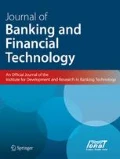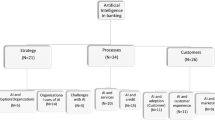Abstract
Despite the limitations peculiar to Nigerian micro-finance banks in deposit-mobilization initiatives, some banks have managed to deploy technologies to mitigate these constraints. This paper identifies the capabilities responsible for enabling the acquisition and deployment of technologies for deposit mobilization activities with a view to inform policy and management practice. Using data collected from questionnaire administration on the managers of 100 selected micro-finance banks, we identify the technologies deployed; measure investment, operational, marketing and linkage capabilities in the sector using a five-item scale (1 = none and 5 = very high) and examine the technological capabilities that influence the deployment of the technologies. We found out that 28.2% of the banks used Point-of-sale (POS) machines, 10.3% deployed mobile banking technologies, while 33.3% and 20.5% used mobile money and card system technologies respectively for deposit mobilisation activities. The study revealed that technological capabilities in the sector ranged from moderate to high. Our regression model showed that capabilities to penetrate markets, procure and install equipment, negotiate and recruit skilled personnel were 21, 15.24, 5.75 and 0.03 times respectively more likely to influence the deployment of the POS. In addition, ability to link external agents to troubleshoot, test and train staff was 0.08 times more likely to influence the deployment of the POS machine. Capability to assess, procure and install technologies was 0.13 times more likely to influence the deployment of mobile money technologies. The study recommended training through professional bodies and regulatory and knowledge institutions to upgrade technological capabilities in the sector
Similar content being viewed by others
References
Oladele O (1988) Perspectives on finance, banking and economic policy in Nigeria. Heinemann Publisher, Ibadan
CBN (2005). Microfinance Policy, Regulatory and Supervisory Framework for Nigeria. Central Bank of Nigeria, Abuja. December, 14. https://www.cbn.gov.ng/out/publications/guidelines/dfd/2006/microfinance%20policy.pdf. Accessed on November 17, 2017.
Akinboyo OL (2007) Microfinance banks: unlocking the potentials of micro-business activities of the Nigerian rural economy. Central Bank Nigeria Bullion 31(1):23–29
Nwanyanwu OJ (2011) Microfinance in Nigeria: problems and prospects. Afr Res Rev 5(2):87–103
Christen RP, Rosenberg R, Jayadeva V (2004) Financial institutions with a double bottom line: implication for the future of finance. CGAP Occasional Paper, pp. 2. https://www.cgap.org/sites/default/files/CGAP-Occasional-Paper-Financial-Institutions-with-a-Double-Bottom-Line-Implications-for-the-Future-of-Microfinance-Jul-2004.pdf. Accessed 10 Oct 2017
Oladejo MO (2008) Micro businesses and entrepreneurial development: an explanatory accounting procedure in proceeding of the first international conference on social and economic policies and millennium development goals (MDGs) in Africa. Faculty of Social and Management Sciences, Adekunle Ajasin University, Akungba -Akoko, Ondo 12–18 April
World Development Report (2008) World Bank, Washington D.C. www.investordictionary.com. Accessed 13 May 2017
Lall S (1992) Technological capabilities and industrialization. World Dev 20(2):165–186
Gichira R (1999) Policies, strategies and programmes for enhancing the participation of small and medium enterprises in E-trade. Paper prepared for national taskforce on electronic commerce’s strategic workshop held at Safari Park Hotel, 20th April, 2–4
Voudouris I, Lioukas S, Iatrelli M, Caloghirou Y (2012) Effectiveness of technology investment: impact of internal technological capability, networking and investments strategic importance. Technovation 32:400–414
Aderemi HO, Oyebisi TO, Adeniyi AA (2009) Development of a measure for technological capability in the information and communications technology industry in Nigeria. A published paper submitted to globelics 2009, Dakar, Senegal and for the Ph.D. student paper competition
Enos JL (1991) The creation of technological capability in developing countries: a study prepared for the international labour office within the framework of the world employment programme. Printer Publishers, London, p 224
Bell M, Pavitt K (1995) The development of technological capabilities. In: ul Haque I (ed) Trade, technology, and international competitiveness. EDI (Economic Development Institute) Development Studies. The World Bank, Washington, DC
Chang T (1996) Cultivating global experience curve advantage on technology and marketing capabilities. Int Mark Rev 13:22–42
Dutta S, Narasimhan O, Rajiv S (1999) Success in high-technology markets: is marketing capability critical? Mark Sci 18:547–568
Song M, Droge C, Hanvanich S, Calantone R (2005) Marketing and technology resource complementarity: an analysis of their interaction effect in two environmental contexts. Strateg Manag J 26:259–276
McEvily SK, Eisenhardt KM, Prescott JE (2004) The global acquisition, leverage, and protection of technological competencies. Strateg Manag J 25(9):713–722
Day GS (1994) The capabilities of market-driven organizations. J Mark 58:37–52
Oyelaran-Oyeyinka B (1997) Technology and comparative advantage in the context of vision 2010. A paper presented at the workshop of vision 2010 on science, engineering and technology, Abuja, Nigeria
Gockel FA, Brownbridge M (2007) The impact of financial sector policies on banking sector. https://doi.org/10.1111/j.14680084.1996.mp58002008.x/full. Accessed 17 Nov 2017
Kazi AM (2012) Promoting deposit mobilisation and financial inclusion. Speech by Mr. Kazi Abdul Muktadir, Deputy Governor of the State Bank of Pakistan, at the Launch of Easypaisa Khushaal, Karachi, Pakistan, 16 October
Oboh GAT (2005) Selected essay on contemporary issues in the Nigerian banking system. Ibadan University Press, Ibadan
Ugwu EI (2012) An appraisal of the impact of recapitalization of banking industry on economic growth of Nigeria. An unpublished Masters of Business Administration (MBA) in Accountancy Research Submitted to the Department of Accountancy, Faculty of Business Administration, University of Nigeria, Enugu
Maimbo SM (2003) The money exchange dealers of Kabul: a study of the hawala system in Afghanistan. The World Bank, Washington, D.C. Working Paper. 13. http://wwwwds.worldbank.org/servlet/WDS_IBank_Servlet?pcont=details&eid=000090341_20031016085357. Accessed 5 June 2017
Mshauri M (2012) Assessment of the factors that influence deposit mobilisation in Tanzania: the case study of commercial banks, Dar Es Salaam, Tanzania. An unpublished Master of Business Administration (MBA) Research Submitted to the Department of Business Administration, Open University of Tanzania, Tanzania
Sirri E, Tufano P (1995) The economics of pooling. In: Crane DB et al (eds) The global financial system: a functional perspective. Harvard Business School Press, Boston, pp 81–128
Elser L, Hannig A, Wisniwski S (1999) Comparative analysis of savings mobilisation strategies. Consultative Group to Assist the Poorest (CGAP) Working Papers, Eschborn
Laura E, Alfred H, Sylvia W (2009) Consultative group to assist the poorest (CGAP) working on savings mobilisation comparative analysis of savings mobilisation strategies. 12–16 Sept
Tuyishime R, Memba F, Mbera Z (2015) The effects of deposits mobilisation on financial performance in commercial banks in Rwanda. A case of equity bank Rwanda limited. Int J Small Bus Entrep Res 3(6):44–71
Efunwole MS (2018) A study of technological capabilities in the baking industry in Southwestern Nigeria. An unpublished Doctoral Thesis submitted to the African Institute for Science Policy and Innovation. Obafemi Awolowo University, Ile-Ife
National Population Commission (2006) Database management profile. http://population.gov.ng/. Accessed 19 Nov 2017
CBN (2017) Microfinance banks loans to MSMEs hit N214b in Dec 2016—CBN. http://www.vanguardngr.com/2017/06/microfinance-banks-loans-msmes-hit-n214b-dec-2016-cbn/. Accessed 22 July 2017
Lin FJ (2008) Solving multicollinearity in the process of fitting regression models using the nested estimate procedure. Qual Quant 42(3):417–426
Dohoo I, Ducrot C, Fourichon C, Donald A, Humik D (1997) An overview of techniques for dealing with large numbers of independent variables in epidemiologic variables. Prev Vet Med 29(3):221–239
Chen CF, Rothschild R (2010) An application of hedonic pricing analysis to the case of hotel rooms in Taipei. Tour Econ 6(3):685–694
Rogers EM (2003) Diffusion of innovations, 5th edn. Free Press, New York
Raji R (2017) Point of sale (POS)—a veritable tool for deposits mobilizers of microfinance banks. http://microfinanceblog.com/point-of-sale-pos-a-veritable-tool-for-deposits-mobilizers-of-mfb/. Accessed 22 July 2017
Overton R (2007) Feasibility studies made simple. australia, martins book limited. http://trove.nla.gov.au/work/7013169. Accessed 19 Nov 2017
Quélin B, Duhamel F (2003) Bringing together strategic outsourcing and corporate strategy: outsourcing motives and risks. Eur Manag J 21(5):647–661
Author information
Authors and Affiliations
Corresponding author
Rights and permissions
About this article
Cite this article
Awoyemi, S.O., Adejuwon, O.O. & Ogundari, I.O. An assessment of technological capabilities and deposit-mobilisation technologies in selected micro-finance banks in Southwestern Nigeria. J BANK FINANC TECHNOL 5, 59–69 (2021). https://doi.org/10.1007/s42786-021-00028-3
Received:
Accepted:
Published:
Issue Date:
DOI: https://doi.org/10.1007/s42786-021-00028-3




